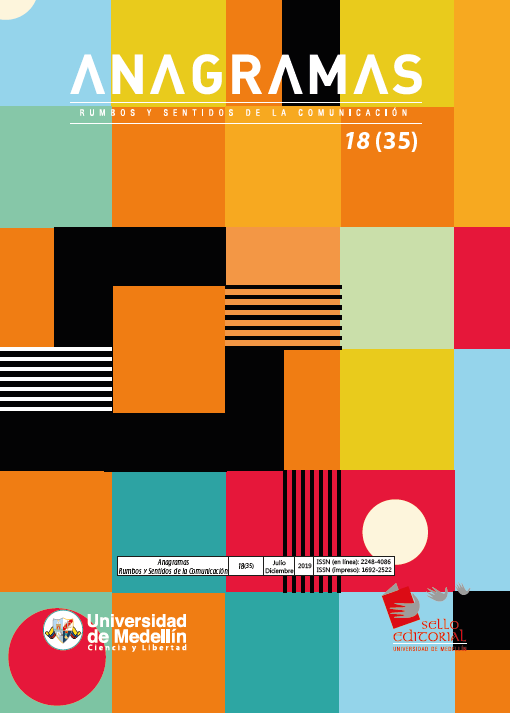The Relationship Between Independent creatives of Public Television and Child Audience
Main Article Content
Abstract
This paper explains how the relationship among independent directors, producers, screenwriters, and researchers of public television from Chile, Colombia, Mexico and child audiences is established, it also sets the criteria to define the target group. For this qualitative study, 21 questionnaires were applied to creatives of broadcasted programs of public television channels like tvn and Novasur from Chile, Canal Once and Canal 22 from Mexico, and Señal Colombia, all of which received nominations or national and international awards since their emissions. The results show that the relation is present by own initiative and not by the channels. Moreover, this is conformed in the same project creation phase to test its viability and in the production stage of contents during recordings. Nevertheless, it is identified that there is no follow-up about the acceptation and appropriation of produced and broadcasted messages by television channels, specially those that produce cultural edu-entertainment shows, as it is one of the objectives of public television. Finally, television creatives give a series of important recommendations for designing a children’s audiovisual project, taking into account aspects such as research, contents, production, and audience participation.
Article Details
References
Aguaded, J. I. (2005). Estrategias de edu comunicacion en la sociedad audiovisual. Revista Comunicar, 24, 25-34.
Almada, M. (2014). Fuimos colores. Canal 22.
Ávila, J., y Acosta, C. (2016). Epistemología del pensamiento visual contemporáneo desde el imaginario transdisciplinario. Anagramas, 14(28), 167-240.
Buzeta, C., y Moyano, P. (2013). La medición de las audiencias de televisión en la era digital. Cuadernos.Info, 33, 53-62. https://doi.org/10.7764/cdi.33.503
Cabrera, L., y Veneras, V. (2013). Mr. Trance. Señal Colombia.
Cáceres, M. D.,y Brändle, G. (2011). El uso de la televisiónen un contexto multipantallas: viejas prácticas en nuevos medios. Análisi, 43, 21-44.
Cahm, A., Kalagian, T., y Lyon, C. (2008). Business Models for Children’s Media. En S. L. Calvert y B. J. Wilson (eds.), The Handbook of Children, Media, and Development (pp. 27-48). Blackwell Publishing. https://doi.org/10.1002/9781444302752
Ceppi, Á. y Covarrubias, H. (2016). Puerto papel. Chile, Brasil, Colombia & Argentina. TVN, Señal Colombia, Gloob & Pakapaka.
Crespo-Pereira, V., Martínez-Fernández, V., y Campos-Freire, F. (2017). Neuroscience for Content Innovation on European Public Service Broadcasters. Comunicar, 52, 09-18. https://doi.org/10.3916/C52-2017-01
Díaz, Á., y Peirano, P. (2014). 31 minutos. TVN.
Egaña, A., y Puga, P. (2010). Tikitiklip. TVN.Esomar (2009). Global Guidelines on Out-of-Home Audience Measurement. Version 1.0. Esomar Recuperado de https://www.esomar.org/uploads/public/knowledge-and-standards/codes-and-guidelines/ESOMAR_Global-Guidelines-on-Out-of-Home-Audience-Measurement_v.1.0.pdf
Federal Communications Commission (fcc) (2016). The V-Chip: Options to Restrict What Your Children Watch on TV. Consumer Guide. fcc. Recuperado de https://www.fcc.gov/consumers/guides/v-chip-putting-restrictions-what-your-children-watch
Fedorov, A. (2014). Media Education Literacy in the World: Trends. European Researcher, 67(1-2), 176-187. https://doi.org/10.13187/issn.2219-8229
Fernandes, T., y Remelhe, P. (2016). How to engage customers in co-creation: customers’ motivations for collaborative innovation. Journal of Strategic Marketing, 24(3-4), 311-326. https://doi.org/10.1080/0965254X.2015.1095220
Gómez, P. (2010). ¿Con quésueñas? TVN.González, C. (2010). La lleva. Ministerio de Cultura, rtvc Señal Colombia, Pontificia Universidad Javeriana y Canal 13.
Gozansky, Y. (2017). From pupils to consumers: the transformation of the concept of childhood in Israeli children’s television. Journal of Children and Media, 11(1), 36-52. https://doi.org/10.1080/17482798.2016.1203809
Hadas, L., y Shifman, L. (2013). Keeping the Elite Powerless: Fan-Producer Relations in the 'Nu Who' (and New YOU) Era. Critical Studies in Media Communication, 30(4), 275-291. https://doi.org/10.1080/15295036.2012.676193
Hall, S. (2012). Encoding/Decoding. En M. Durham y D. Kellner (Eds.), Media and Cultural Studies: Keywords (2° ed, pp. 137-144). John Wiley & Sons.
Hallvard, M., Poell, T., y van Dijck, J. (2015). Rearticulating Audience Engagement: Social Media and Television. Television & New Media, 17(2), 99-107. https://doi.org/10.1177/1527476415616194
Hartley, J. (2002). Cultural and Media Studies: The Key Concepts (Third Edit). Routledge.
Livingstone, S. (2005). On the relation between audiences and publics. En S. Livingstone (Ed.), Audiences and publics: when cultural engagement matters for the public sphere (Vol. 2, pp. 17-42). Cultural Studies Intellect. https://doi.org/10.1177/02673231080230030504
Livingstone, S., y Das, R. (2013). The end of audiences? En J. Hartley, J. Burgess y A. Bruns (eds.), A Companion to New Media Dynamics (pp. 104-121). Blackwell Publishing. https://doi.org/10.1002/9781118321607
Martínez, C. (2016). 'They Are Totally Unfiltered': Constructions of the Child Audience among Swedish Advertising Producers. Television & New Media, 1-17. https://doi.org/10.1177/1527476416637676Martínez, T. (2016). Mi lugar. Once Niños.
Mayer, V. (2016). The Places Where Audience Studies and Production Studies Meet. Television & New Media, 1-13. http://doi.org/10.1177/1527476416652482
Ortega, F., González Ispierto, B., y Pérez Peláez, M. E. (2015). Audiencias en revolución, usos y consumos de las aplicaciones de los medios de comunicación en tabletas y teléfonos inteligentes. Revista Latina de Comunicacion Social, 70, 627-651. https://doi.org/10.4185/RLCS-2015-1063
Ortega, F., Pereira, C., e Igartua, J. J. (2016). A quantitative approach to the television programs aimed to child and youth audience in Brazil. Communication & Society, 29(3), 49-67. https://doi.org/10.15581/003.29.3.49-68
Pearce, L. J., y Field, A. P. (2016). The Impact of 'Scary' tv and Film on Children’s Internalizing Emotions: A Meta-Analysis. Human Communication Research, 42(1), 98-121. https://doi.org/10.1111/hcre.12069
Pérez Tornero, J., Martínez-Cerdá, J. F., Portalés Oliva, M., Durán Becerra, T., Peralta García, L. y Julià Cano, A. (2015). Showing films and other audiovisual content in European Schools Obstacles and best practices. Digital Agenda for Europe. https://doi.org/10.2759/038024
Piotrowski, J. T. (2014). Participatory Cues and Program Familiarity Predict Young Children’s Learning From Educational Television. Media Psychology, 17(3), 311-331. https://doi.org/10.1080/15213269.2014.932288
Rincón, M., Rincón, M.,y de Jesús, U. (2010). Guillermina y Candelario. Señal Colombia.
Salazar, O. (2012). Kiplata. Canal Once.Sánchez, M. (2013). El mundo animal de Max Rodríguez. Señal Colombia, Pakapaka, Tribu 70 y Centro Ático.Santamaría, Y. (2013). Camusi camusi. Señal Colombia.
Sekarasih, L., Nayar, K., O’Malley, D., Olson, C., y Scharrer, E. (2016). Entertaining audiences, ensuring inclusivity, and considering media influence: Sixth graders’ understanding of media producers’ responsibility. The Communication Review, 19(2), 128-152. https://doi.org/10.1080/10714421.2016.1161338
Vega, J., y Lafaurie, A. (2013). Observar tv: Un observatorio infantil de televisión para la interlocución de los niños. Revista Comunicar, 20(40), 145-153. https://doi.org/10.3916/C40-2013-03-05
Veloso, P. (2015). Pichintún. Chile: cntv, Novasur.
Zanker, R. (2011). Producers Speak: Creating Civic Spaces for New Zealand Children. Media International Australia, (139), 32-41.





